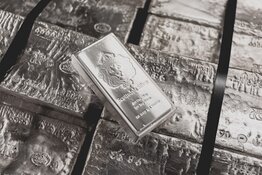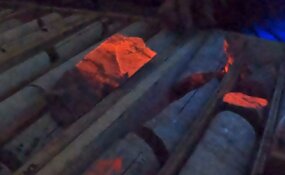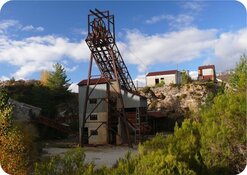The Gold Report: VSA Capital recently published a research report that reads, "One of the key parts of exploration funding and the acceptance of risk versus monetary reward was the considerable correlation between share price appreciation and the reduction of geological risk." However, this no longer seems to be the case. What's broken?
Paul Renken: What has transpired for the last couple of years, particularly in the junior and very small-cap exploration space, is that the money to find deposits and advance them along the risk profile to a bankable state has largely disappeared. The dollars required to define a resource have been viewed by the market as an opportunity to sell shares to take advantage of any short-term price strength. From the long-term shareholders' point of view, the money was wasted. Companies should have sat on the cash and not bothered with any exploration.
"Metallurgical testing on Mkango Resources Ltd.'s REE deposit in Malawi suggests that it should be fairly easy to process with relatively high rates of recovery."
The directors of these companies need to realize that at the early stages of a project, they have to consider the probability of finding a significant deposit and how much it's going to cost to define it. Investors, and institutional investors in particular, are looking for very low costs of discovery.
TGR: Has that become part of your investment thesis for junior resource equities?
PR: Yes, we're looking to bottom-fish particularly good stories with good deposits that have languished for some time but that are now showing good economics. There are many firms out there seeking capital but there just isn't much capital to finance all of them, or even the majority. If you're going to commit capital to bring some of these stories to production, why not cherry-pick the best stories and the best deposits at the most economical cost? The smaller you get in the resource space, the good deposits or good corporate stories are available at very low valuations simply because the sector has been so out of favor for so long.
TGR: When is risk capital going to return to the sector?
PR: The exploration side of the business, a subsector of the mining space, needs to show that it has the same or greater potential for a return on investor capital versus other sectors. It is a competition for the available dollars among all the different companies in all the different sectors—as well as debt capital and currency markets—not just other mining companies.
"Largo Resources Ltd.'s large Maracás iron-vanadium project in Brazil is in the commercial ramp-up stage."
We seem to be at the bottom or bouncing along the bottom in the small-cap mining space. I'm looking forward to seeing some signs, likely in a matter of weeks, that we have seen the bottom of the market.
TGR: Where in the bulk commodity space should investors look for performing equities?
PR: Companies that have a strong component of their earnings in industrial metals—lead, zinc, nickel, etc.—should do better than those in the iron ore space. As a large-cap company, Glencore International Plc (GLEN:LSE) is likely best positioned among large mining firms listed in London. Glencore is pretty well situated in metallurgical coal and base metals concentrates, particularly lead-zinc concentrates. It is also getting involved in vanadium. It has its finger on the pulse of a variety of different bulk commodities that are traded on the London Metal Exchange, as well as on the mining side.
TGR: You cover a number of industrial commodities, including tungsten. Tungsten has the highest melting point of any metal, but at $370/metric ton unit ($370/mtu), it's not exciting many investors. What's the investment case for tungsten?
PR: Tungsten's primary use is in carbide cutting tools, essentially a proxy for manufacturing activity. If the banks and governments across the world are going to get the economy moving faster, they have to increase manufacturing activity. Manufacturing activity means being able to create, cut and sell metal—everything from fabricated products to metallic tools to sheet metal, including auto body panels.
Auto manufacturing is increasing in both China and the United States. And because China wants to maintain its manufacturing dominance, it is no longer exporting tungsten as it did in the 1980s, when it essentially swamped the worldwide tungsten market. These days, some sources say as much as three-quarters of the arable land in China is contaminated. The Chinese must address this issue and that means no longer accepting quick and dirty methods of metals production. We expect Chinese tungsten exports to continue to tighten, and therefore tungsten should have fairly robust demand going forward.
TGR: What are some tungsten equities that you follow?
PR: We cover a few names that are already producing, but primarily we cover companies in the exploration and development stages, like Northcliff Resources Ltd. (NCF:TSX.V). It has the Sisson tungsten project in eastern Canada. The feasibility study is complete and the company is working on permitting and financing.
TGR: Northcliff is part of the Hunter Dickinson group of companies, which is based in Vancouver. How much of an advantage is that?
"A darling among uranium investors over the past couple of years is Fission Uranium Corp."
PR: It essentially allows Northcliff to consolidate its general and administrative costs and be able to call upon a group of experienced professionals from a wide variety of disciplines—legal, engineering and capital finance. It's a pretty sizable advantage because it doesn't have to pay the full-cost rates that it would if it hired those people as a standalone company. Also, Hunter Dickinson has been successful over the years in monetizing corporate stories and assets to the benefit of investors. It's a good brand name.
TGR: Are there other tungsten equities that you're following?
PR: I will give you three others. The first is Largo Resources Ltd. (LGO:TSX.V). Its large Maracás iron-vanadium project in Brazil is in the commercial ramp-up stage, but it also has a tailings retreatment project for tungsten in Brazil that has been put on care and maintenance because of a lack of water. Largo also has another large, low-grade tungsten deposit in Canada's Northwest Territories that has been sitting idle for a while.
TGR: So Largo is primarily a vanadium story. How long will it take for the Maracás iron-vanadium project to become economic?
PR: The ramp-up period will last a good 12 months. The company is just in the process of roasting its first ore. Full-scale commercial production will likely happen well into next year.
The next one is a little firm on the London market called Thor Mining Plc (THR:LSE; THR:ASX). Thor is working on a definitive feasibility study at its Molyhil molybdenum-tungsten project in Australia and the company just acquired another early-stage tungsten property in Nevada. That particular company is for investors who want a play in a very small space with a pretty interesting story.
TGR: And the last tungsten story?
PR: The other firm is Blackheath Resources Inc. (BHR:TSX.V), an exploration-stage company. The Blackheath management team is essentially the same one that was successful for investors under Primary Metals Inc. Primary Metals owned the Panasqueira tungsten mine in Portugal from 2003 until 2007, when the company sold it at a profit. Now that management team has returned to Portugal under Blackheath and has picked up tungsten districts and mines that were productive from World War II through to the 1960s. The company is now re-exploring and attempting to redevelop those deposits, virtually none of which were ever drilled. I can't imagine that the old miners, against all odds, found all the economic tungsten mineralization. So far the results are looking good.
TGR: You also follow the rare earth elements (REE) subsector. It seems to be the most volatile, yet Reuters reports that two of its biggest players, Lynas Corp. (LYC:ASX) and Molycorp Inc. (MCP:NYSE), may have finally overcome their many challenges to become bona fide REE producers. Should investors believe the hype?
PR: Lynas and Molycorp have disappointed investors simply because they are taking too long and using too much money to reach their goals. Lynas has become the poster child for social action as part of an effort to prevent its concentration and treatment plant from operating in Malaysia, whereas Molycorp continues to have issues with bringing its mine back to the level of commercial production that it had achieved decades earlier. In both cases institutional investors are going to have to be very patient to realize any return on capital.
TGR: What's your view on the REE space in general?
PR: I'm positive on the REE space. Further down the food chain there are a number of interesting REE stories with simpler mineralogy that should require simpler plants and processes to produce REE. That means their capital expenses should be a lot less, too. The Chinese have controlled REE production for a number of years but China is trying to seize greater control of the market inside its borders because there has been so much illegal REE mining and smuggling.
The Chinese realize that the volatility experienced in REE pricing just a few years ago caused many end users to seek alternatives. The subsequent steep decline in REE prices has been difficult for Chinese REE producers. By the same token, annual REE demand growth is in the high single-digit range. That's expected to continue for some time.
TGR: What are some REE equities you're following?
PR: Among the rare earth explorers and developers we watch is a company called Mkango Resources Ltd. (MKA:TSX.V). It has a REE project in Malawi in southeastern Africa. Mkango should soon announce its prefeasibility results. Metallurgical testing done to date on the deposit's mineralization suggests that it should be fairly easy to process with fairly high rates of recovery. I'm looking forward to seeing the capital requirements it needs to put its project into production.
TGR: Mkango recently appointed Derek Linfield as chairman. He has some experience getting Canada-listed companies listed in London. Is that one of the main reasons Mr. Linfield was brought on board?
PR: Mkango is interested in cultivating institutional shareholder interest around London and in this hemisphere. Being an Africa-focused REE developer, I think the board sees London as a natural marketplace to raise capital for a REE mine.
TGR: Perhaps one more REE junior?
PR: Another one is Tasman Metals Ltd. (TSM:TSX.V; TAS:NYSE.MKT; TASXF:OTCPK; T61:FSE). Tasman has two REE deposits, but the primary one is called Norra Kärr in Sweden. That particular deposit is relatively low grade in total REE at below 1%, but geologically it is skewed toward the heavy rare earths. It may also very well be quite profitable. The other interesting thing is that it is the only rare earth deposit in the development stage with a direct market into the European Union (EU). The EU has declared REEs to be among a number of different metals and materials, including tungsten, that are critical to its industrial future as a trading block. I suspect that once the Norra Kärr feasibility study is complete, some financing doors will open in short order.
TGR: In a February 2014 interview, you told us that investors should be in precious metals, gemstones and uranium. While precious metals' prices were up in the first half of this year and the diamond equities you mentioned have performed, uranium continues to flounder. Is it as simple as asking investors to have more patience?
PR: It certainly has been a disappointment for uranium investors and for analysts who can see that it should be performing much better. The issue is that Japan has not brought its nuclear program back on-line. Japan has a surplus of uranium from long-term contracts that it can't use because those reactors are not operating.
Japan is forced to resell that material for whatever it can get. This is costing the Japanese economy billions. How long will it continue to do this? It has already gone on longer than any of us anticipated. The government intends to bring these reactors back on-line at some point, when it is satisfied that it is safe to do so.
TGR: What should investors do?
PR: If they are still holding uranium equities, they must decide whether it's worth holding that position. A few uranium equities out there are definitely good bottom-fishing situations because the grade or size of the deposit dictates that they will be put into production as long as there is a global nuclear industry.
TGR: Please share some with us.
PR: A darling among uranium investors over the past couple of years is Fission Uranium Corp. (FCU:TSX.V). It's run by CEO Ross McElroy and Chairman Dev Randhawa, who successfully sold the Waterbury Lake discovery and several other assets to Denison Mines Corp. (DML:TSX; DNN:NYSE.MKT). And then Fission hit very high-grade uranium at the Patterson Lake South deposit.
It has really come up trumps with that project. Continuity has been established between the individual ore bodies, and Fission continues to add resource size through drilling. The company has not yet declared a resource, but the suspicion among analysts is that it's between 50–100 million pounds contained uranium. It's going to be mined; it's a question of by whom and for how much.
TGR: Fission's success spawned a staking rush in the area. Are there latecomers that have something to offer investors?
PR: A couple of names that come to mind are Lakeland Resources Inc. (LK:TSX.V) and Azincourt Uranium Inc. (AAZ:TSX.V). Lakeland is headed up on the exploration side by a former geologist working for Fission. It is working projects in the Athabasca Basin looking for near-surface uranium mineralization primarily on the northern and eastern edges of the basin. Azincourt and the Fission Uranium exploration assets spinoff company Fission 3.0 Corp. (FUU:TSX.V) are in joint venture on the property immediately north of Patterson Lake South. Fission's chairman, Dev Randhawa, is on the board and the Azincourt chairman, Ian Stalker, we know as well. Azincourt also holds ground in the Macusani uranium district in Peru, a project we were previously familiar with through Vena Resources Inc. (VEM:TSX ; VEM:BVL; V1R:FSE).
TGR: Could you give us an overview on the nickel space?
PR: The nickel space has been quite interesting ever since the Indonesian export ban went into effect in January. It's done wonders for the value of nickel. The price moved to the $9/pound ($9/lb) range from about $6.50/lb. We expect nickel to stay in that range until Chinese pig iron producers are able to source other nickel-laterite ore or cheap nickel concentrates. Until a source is found, we think the price will remain strong.
TGR: What are some nickel equities with leverage to the nickel price?
PR: One company that is particularly levered to the nickel price is Royal Nickel Corp. (RNX:TSX), which has the Dumont nickel deposit in Québec.
TGR: Do you want to discuss gemstones?
PR: The fundamentals for diamonds were looking quite good at the end of 2013 and that has proven to be the case. Most diamond equities, particularly the producing equities, are showing nice gains this year. That's based on improvements in both cut and raw stone prices on the auction tenders of these companies over the first seven months of 2014. U.S. and Asian retail demand continues to improve and we're comfortable projecting further gains.
Among the names are Gem Diamonds Ltd. (GEMD:LSE; GEMD:VIRTX; ZVW:FSE); Petra Diamonds (PDL:LSE; PDMDF:OTCPK); and Dominion Diamond Corp. (DDC:NYSE; DDC:TSX), formerly Harry Winston. Those are names that I follow closely.
TGR: In a report titled, "Emerging Market Forex and the End of the Commodity Market Super-Cycle," Goldman Sachs says that bulk commodities, like iron ore, copper and oil, will see five years of price softness to the tune of $80/ton iron ore, $6,600/mtu copper and $100/barrel for Brent crude. Do you concur?
PR: We'll probably see some volatility in that very flat marketplace. Goldman Sachs is quoting prices that are 10–20% under the current prices, yet some of these prices are moving in the opposite direction. For instance, geopolitical risk is pushing up the price of Brent crude.
To reach $3/lb or lower for a sustained period, copper would require a significant surplus over the next five-year period. The amount of copper coming into the market has been consistently lower than analysts' projections. Last year, there was a slight deficit. There may be as much as a 400,000-tonne surplus this year in my view, but that isn't significant enough to sway prices. I would peg the five-year average copper price closer to $3.20/lb.
As far as iron ore is concerned, it may try to test $80/ton at some point, particularly if there's a decline in steel output in China. I suspect that the overall average for five years would be closer to $90–100/ton for 62% iron CFR (cost and freight).
TGR: Parting thoughts?
PR: I'm hopeful that we are looking at the bottom for mining equities. We may see another trading range for gold and for silver. Silver is certainly playing out according to what we had anticipated at the end of last year. Gold is a bit stronger than we had expected, largely because of geopolitical risk and retail interest from Asian investors. Platinum group metals prices are looking quite good and will continue to because of labor risk in South Africa and geopolitical risk in Russia. Overall, we see strength in a number of different commodities. It's time for equities to catch up.
TGR: Thank you for talking with us, Paul.
Paul Renken has a broad range of experience in various aspects of the mining and minerals business. He began his career as a geologist for Canadian junior resource companies in the western United States. Owning a stake in a private consulting firm as vice president of exploration, Renken searched for various base metals, precious metals and industrial minerals. In the UK, he worked in the equity market media outlets of Digitallook and Hemscott before joining VSA as mining analyst in 2006.
Read what other experts are saying about:
Want to read more Gold Report interviews like this? Sign up for our free e-newsletter, and you'll learn when new articles have been published. To see recent interviews with industry analysts and commentators, visit our Streetwise Interviews page.
DISCLOSURE:
1) Brian Sylvester conducted this interview for Streetwise Reports LLC, publisher of The Gold Report, The Energy Report, The Life Sciences Report and The Mining Report, and provides services to Streetwise Reports as an independent contractor. He owns, or his family owns, shares of the following companies mentioned in this interview: None.
2) The following companies mentioned in the interview are sponsors: Largo Resources Ltd., Azincourt Uranium Inc., Fission Uranium Corp. and Mkango Resources Ltd. Lakeland Resources Inc. is affiliated with Zimtu Capital Corp. Streetwise Reports does not accept stock in exchange for its services or as sponsorship payment.
3) Paul Renken: I own, or my family owns, shares of the following companies mentioned in this interview: None. I personally am, or my family is, paid by the following companies mentioned in this interview: None. My company has a financial relationship with the following companies mentioned in this interview: Thor Mining Plc, Northcliff Resources Ltd., Blackheath Resources Inc. and Royal Nickel Corp. I was not paid by Streetwise Reports for participating in this interview. Comments and opinions expressed are my own comments and opinions. I had the opportunity to review the interview for accuracy as of the date of the interview and am responsible for the content of the interview.
4) Interviews are edited for clarity. Streetwise Reports does not make editorial comments or change experts' statements without their consent.
5) The interview does not constitute investment advice. Each reader is encouraged to consult with his or her individual financial professional and any action a reader takes as a result of information presented here is his or her own responsibility. By opening this page, each reader accepts and agrees to Streetwise Reports' terms of use and full legal disclaimer.
6) From time to time, Streetwise Reports LLC and its directors, officers, employees or members of their families, as well as persons interviewed for articles and interviews on the site, may have a long or short position in securities mentioned. Directors, officers, employees or members of their families are prohibited from making purchases and/or sales of those securities in the open market or otherwise during the up-to-four-week interval from the time of the interview until after it publishes.









































